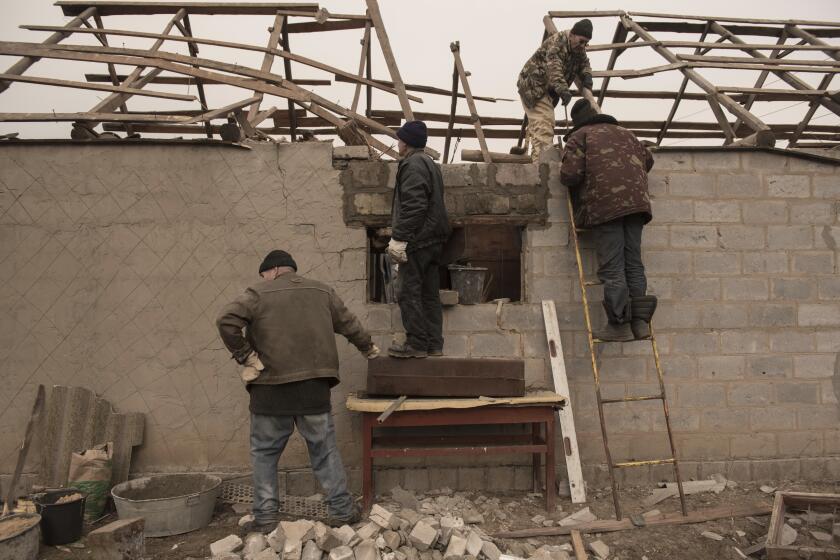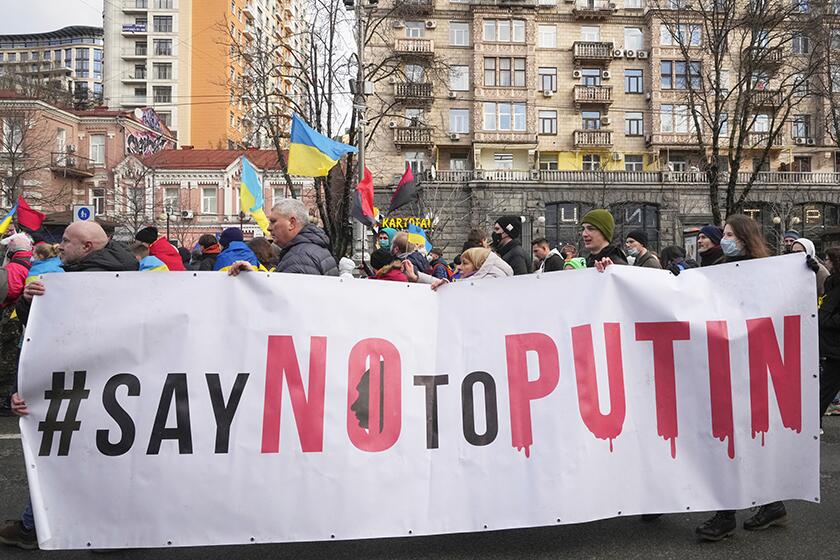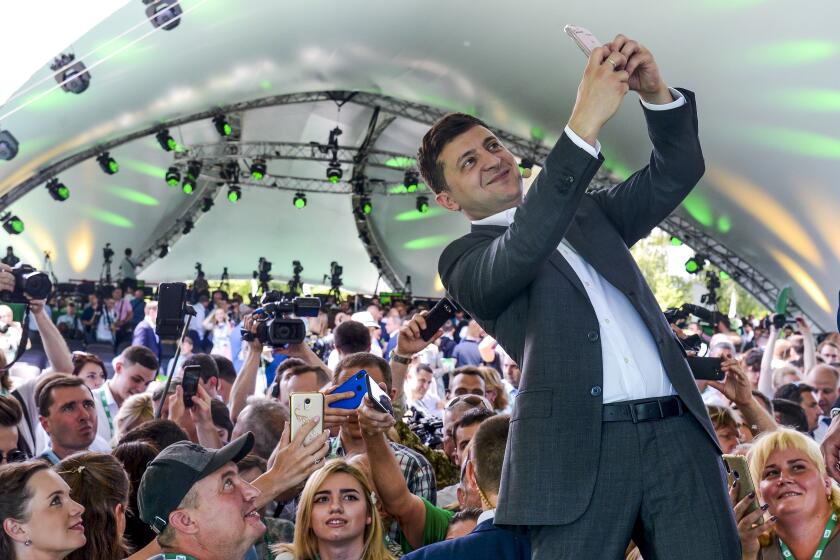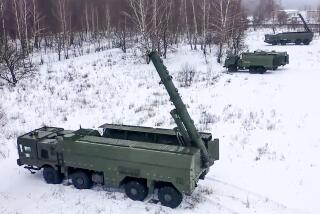U.S. and NATO officials ramp up warnings of potential Russian aggression in Ukraine
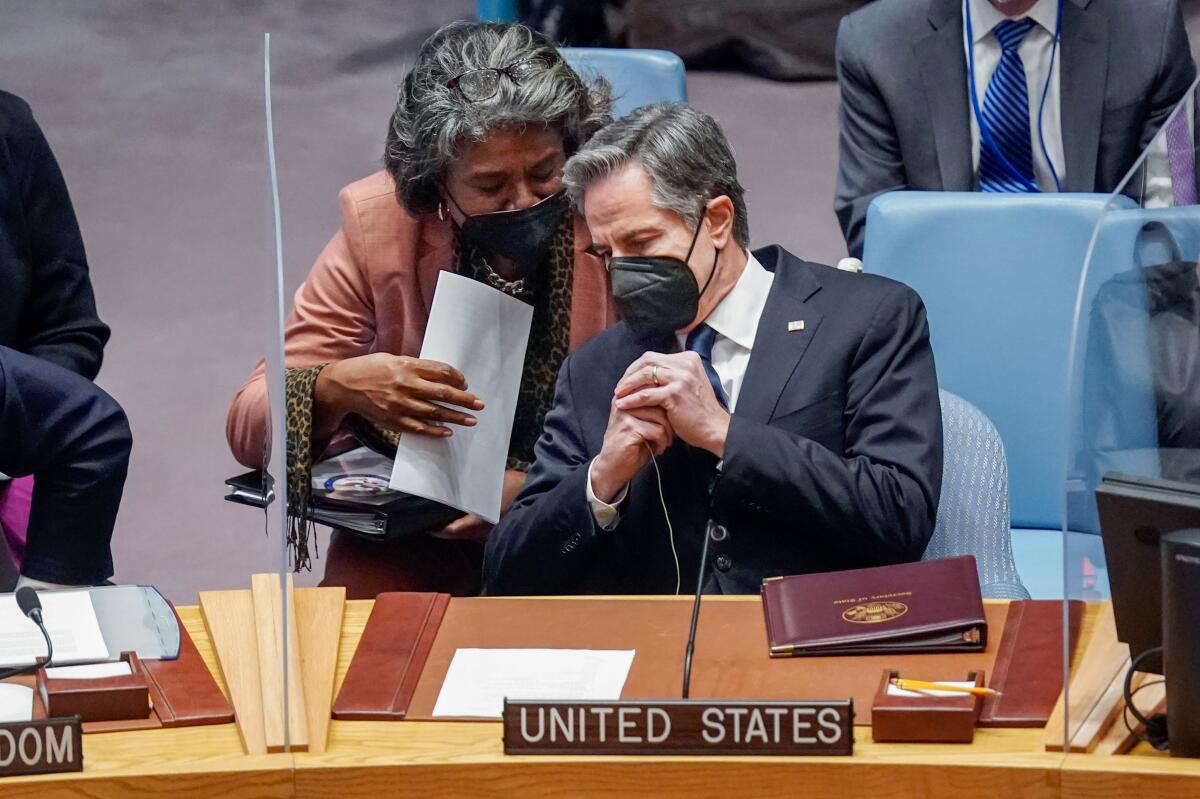
- Share via
WASHINGTON — Secretary of State Antony J. Blinken warned Thursday that Russia “is preparing to launch an attack” against Ukraine, echoing earlier comments from U.S. and Western officials who said that an invasion could come any day and that Moscow would seek to use disinformation to create a pretext for such an assault.
“The most immediate threat to peace and security is Russia’s looming aggression against Ukraine,” Blinken said during an impromptu stop at a U.N. Security Council meeting to discuss developments. “The stakes go far beyond Ukraine. This is a moment of peril for the lives and safety of millions of people.”
Even though Western officials have said they were holding out hope for diplomacy, their dire rhetoric on Thursday, as well as actions taken by the Kremlin, underscored a sense that a conflict was inevitable and imminent. The State Department on Thursday said Russia expelled the second-most senior official at the U.S. Embassy in Moscow. And President Biden reiterated to reporters on Thursday morning assertions made by administration officials over the last week that there was a “very high” probability of Russia attacking its western neighbor, perhaps in “the next couple of days.”
The specter of an invasion intensified throughout the day as Ukrainian officials blamed Russia-backed separatists in the eastern part of the country for barrages of artillery, including shells that hit a kindergarten. No children were reported injured, but Ukrainian President Volodymyr Zelensky released a statement on Twitter calling the attack “a big provocation.”
Biden said the U.S. on Thursday had received a letter from the Russian government in response to one Blinken had sent to the Kremlin rebuffing its major demands, including one precluding NATO membership for Ukraine. The reply from Russia’s Foreign Ministry on Thursday left little room for diplomacy. It blamed the U.S. and the West for the crisis and said it had not received the security guarantees it required. The missive suggested there was only one way to resolve the situation: through force.
“In the absence of readiness of the U.S. side to negotiate solid, legally binding guarantees of our security by the U.S. and its allies, Russia will have to react, including via implementation of measures of military-technical nature,” the Foreign Ministry wrote, according to the Russian state news agency Tass.
Biden and other U.S. officials have promised that any Russian invasion would result in swift sanctions being levied against Moscow. “Our response will be sharp and decisive,” Blinken said at the United Nations.
Blinken has agreed to meet with Russian Foreign Minister Sergei Lavrov late next week, “provided there is no further Russian invasion of Ukraine,” said State Department spokesman Ned Price. “If they do invade in the coming days, it will make clear they were never serious about diplomacy.”
False images and narratives of Ukrainian atrocities and other allegations have been spread by Russia-aligned media and digital actors.
Russian Deputy Foreign Minister Sergei Ryabkov, speaking before Blinken in New York, said there have been enough “baseless accusations” leveled against Moscow over the potential for an invasion. He also noted that U.S. officials and others said they expected an invasion to be launched Feb. 16, a date that has come and gone.
“My advice to you,” Ryabkov said, presumably addressing Blinken, “is not to put yourself in an awkward situation.” He also accused Ukraine of engaging in a campaign against ethnic Russians, an allegation that Western leaders have criticized as being part of the disinformation campaign. “We have thousands of victims of the internal armed conflict, and many millions in Donbas are still presented as foreigners in their own country.”
Russian President Vladimir Putin has hoped his steady buildup of forces on Ukraine’s borders — now surpassing 150,000 troops — would compel the North Atlantic Treaty Organization to give him a guarantee that Ukraine, a former Soviet republic, would never be granted NATO membership.
Putin has long expressed disdain for Ukraine’s independence from Russia and the prospect of its aligning itself more closely with the rest of Europe. His annexation of Crimea from Ukraine in 2014 drew global condemnation and economic sanctions from the West. But the resulting punishment has not seemed to deter him from contemplating another invasion.
The U.S. and other NATO members are privately reluctant to admit Ukraine, which would make the organization responsible for guaranteeing its military defense. But thus far NATO leaders have held firm in their refusal to give Putin such a guarantee, even though it could avert an armed conflict. They say such a decision should be up to Ukraine and NATO members, not dictated by Moscow.
U.S. and NATO officials have labored for weeks to highlight efforts by Russian leaders to blame Ukraine for any eventual attack. They have also expressed deep skepticism about reports that Russia was drawing down forces in the region or was open to reaching a diplomatic solution to the crisis.
Moscow has insisted that it was withdrawing troops and materiel from near Ukraine, moves that Western leaders would see as potential signs that the Kremlin is seeking to reduce tensions. The purported troop withdrawals have been highlighted in videos and statements issued by the Russian Defense Ministry, with one such video depicting a train pulling flatbed carriages loaded with armored vehicles as it crossed a bridge in Crimea to “the point of permanent deployment,” meaning their regular base.
Putin has also signaled an interest in diplomacy. The claims of troop withdrawals and Putin’s hints at being interested in negotiations have raised hopes the Kremlin may back down from a confrontation.
But NATO Secretary-General Jens Stoltenberg and U.S. Defense Secretary Lloyd J. Austin III continued to express skepticism.
At separate news briefings during NATO meetings in Brussels, the two officials disputed Russian claims that Putin had ordered a withdrawal of some troops massed at the border. In fact, Austin said, Russia has deployed more soldiers to the region. A senior administration official on Wednesday night pegged the number of additional soldiers dispatched by Russia at about 7,000.
“I know firsthand that you don’t do these sorts of things for no reason,” said Austin, who served in the U.S. Army for four decades, rising to become a general. “And you certainly don’t do them if you’re getting ready to pack up and go home.”
Stoltenberg described the situation as “dangerous,” with Russia having “enough troops and capabilities to launch a full-fledged invasion of Ukraine with very little or no warning.” He also said that Moscow was almost certain to deploy disinformation to create a pretext for war.
Biden told reporters that “we have reason to believe that they are engaged in a false-flag operation to have an excuse to go in.”
Biden administration decision to relocate its embassy in Ukraine follows the State Department’s urging of Americans to leave the country.
The U.S. and its Western allies have been trying to fend off any Kremlin disinformation campaign by repeatedly and publicly warning that Putin was going to stage attacks or take other actions he could blame on Ukraine to justify an invasion. They did so again Thursday, expressing doubt about claims by Russia that Ukraine is to blame for reported shelling and gunfire exchanged with the Russia-backed separatists in eastern Ukraine’s Donbas region.
Austin said the U.S. is investigating the incidents, adding that they fit into the Russian disinformation playbook that allies have been warning about. The Defense secretary and Stoltenberg faced questions about the reliability of their evidence, given prior intelligence failures and warnings by U.S. and NATO officials in recent days that a Russian attack was imminent.
“I don’t see this as a competition of narratives,” Austin said, pointing to Russia’s record. He said he expects Moscow to launch more cyberattacks and “false flag” narratives blaming Ukraine.
Some Ukrainians are starting to wonder whether their neophyte leader has the smarts and strength to lead them through a moment of peril.
“We’re beginning to see more and more of that,” he said.
Shelling is a part of life in the Donbas region, where for eight years Ukraine’s government has battled separatists who seek to create breakaway republics around the cities of Donetsk and Luhansk. The fight, largely stalemated, still causes casualties that add to the more than 14,000 killed so far and the tens of thousands more wounded. Russia denies it is part of the conflict, but in recent days officials, including Putin, have spoken of ethnic Russians in Donbas facing genocide and have said that Moscow will intervene to protect them.
With NATO forces — not to mention an army of online activists and open-source analysts — keeping a vigil for any escalation, Thursday’s bombardment took on greater importance. It was also more fierce than in recent weeks.
The Ukrainian military said it counted more than 40 cease-fire violations, many of them involving 122-millimeter artillery and other heavy weaponry. Some of the ordnance slammed into a kindergarten in Stanytsia Luhanska, a village over the cease-fire line in Ukrainian-held territory. Video and images depict a hole punched through a brick wall, with masonry scattered over a playroom in a nursery. Authorities said three adults were concussed but no children were hurt.
Ukrainian officials flew reporters to the village to examine the kindergarten. Hours after they returned, shells struck the village again and ignited a gas fire. Two soldiers were also wounded in a bombardment on another village. There were no reported fatalities.
“It’s important that diplomats and the OSCE [Organization for Security and Cooperation in Europe] remain in; their monitoring activities are an additional deterrent,” Zelensky said. “We need an effective mechanism for recording all cease-fire violations.”
At NATO headquarters, Austin and Stoltenberg urged Russia to seek a diplomatic solution to the crisis. But they acknowledged that the tension between Russia and the rest of Europe could linger, leaving Western allies on the razor’s edge in what Stoltenberg called “a new normal” reminiscent of the Cold War.
“We have seen this trend over many years, where Russia contests fundamental principles for European security,” he said, warning that Moscow would continue to “intimidate countries in Europe” to disrupt defense alliances.
Bierman reported from Dalton, Mass., Wilber from Washington and Bulos from Kyiv. Times staff writer Tracy Wilkinson in Washington contributed to this report.
More to Read
Get the L.A. Times Politics newsletter
Deeply reported insights into legislation, politics and policy from Sacramento, Washington and beyond. In your inbox three times per week.
You may occasionally receive promotional content from the Los Angeles Times.
